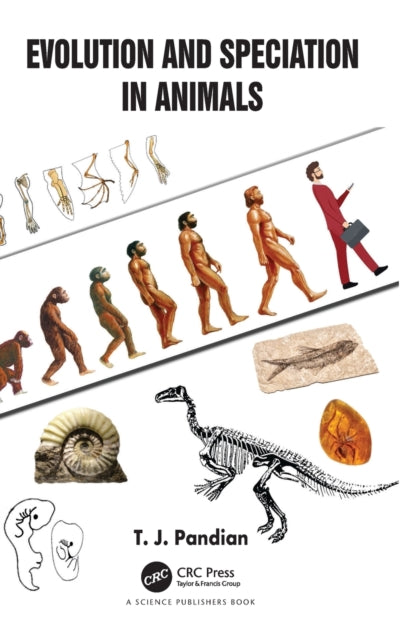T. J.Pandian
Evolution and Speciation in Animals
Evolution and Speciation in Animals
YOU SAVE £7.68
- Condition: Brand new
- UK Delivery times: Usually arrives within 2 - 3 working days
- UK Shipping: Fee starts at £2.39. Subject to product weight & dimension
Bulk ordering. Want 15 or more copies? Get a personalised quote and bigger discounts. Learn more about bulk orders.
Couldn't load pickup availability
- More about Evolution and Speciation in Animals
This book explores how environmental factors and life history traits affect animal diversity, with 15% of species in marine habitats, 8% in freshwater, and 77% on land. Harsh environments limit diversity, while modes of food acquisition, hermaphroditism, and egg size influence it. Evolution is driven by males, with larger egg sizes and extra-ovarian vitellogenesis accelerating diversity. Body size and fecundity are determined by factors, while indirect life cycles, feeding larval stages, and parasitism contribute to faster diversity. Conservation is crucial due to the reduced conservation mechanism and the flourishing of temperature-resistant individuals during global warming.
Format: Hardback
Length: 334 pages
Publication date: 23 September 2021
Publisher: Taylor & Francis Ltd
This groundbreaking book makes a pioneering effort to quantify the environmental factors and life history traits that either accelerate or hinder the diversity of animal species. Astonishingly, approximately 15%, 8%, and 77% of all species inhabit marine environments, accounting for 70% of the Earth's surface. Surprisingly, terrestrial habitats, characterized by their firm ground, foster a greater diversity of species. However, harsh environments such as deep-sea hadal, desert, and elevated montane habitats impose severe restrictions on species diversity, limiting it to a mere 0.5-4.2%. These challenging habitats require more time and energy, resulting in limited food acquisition modes such as osmotrophic and suspension, which further hinder diversity.
Interestingly, hermaphrodites that self-mate and parthenogens exhibit a four-fold higher incidence of heterogamety in males compared to females. This suggests that evolution is predominantly driven by male-specific traits. Furthermore, environmental factors play a crucial role in determining egg size, while genetic factors determine the fixed nature of lecithality. In poikilothermic organisms, sex determination involves both genetic and environmental factors, with environmental factors influencing differentiation.
The preferred reproductive strategies among animals include extra-ovarian vitellogenesis (>96%), spermatozoan (81%) rather than spermatophore mechanism of sperm transfer, promiscuity and polygamy over monogamy, iteroparity (99.6%) over semelparity, and internal fertilization (84%). These strategies accelerate diversity by promoting genetic exchange and variation.
Body size and egg size significantly influence fecundity, with indirect life cycles (82%) and incorporating feeding larval stages further accelerating diversity. Conversely, brooding and viviparity (6.4%) decelerate this process. Parasitism extends the lifespan of individuals and liberates fecundity from the constraints of eutelism, thereby contributing to the overall diversity of animal species.
Evolution is an ongoing and dynamic process, characterized by speciation and extinction as natural outcomes. The remarkable conservation mechanism that allows life to resurface after periods of dormancy has evolved significantly. From a few million years in microbial spores to a few thousand years in plant seeds and a few hundred years in dormant eggs in animals, this process has become more efficient. Consequently, animal conservation has become an urgent priority, as the survival of temperature-resistant/insensitive individuals, strains, and species is crucial for the stability and resilience of ecosystems.
Weight: 608g
Dimension: 234 x 156 (mm)
ISBN-13: 9781032009193
This item can be found in:
UK and International shipping information
UK and International shipping information
UK Delivery and returns information:
- Delivery within 2 - 3 days when ordering in the UK.
- Shipping fee for UK customers from £2.39. Fully tracked shipping service available.
- Returns policy: Return within 30 days of receipt for full refund.
International deliveries:
Shulph Ink now ships to Australia, Belgium, Canada, France, Germany, Ireland, Italy, India, Luxembourg Saudi Arabia, Singapore, Spain, Netherlands, New Zealand, United Arab Emirates, United States of America.
- Delivery times: within 5 - 10 days for international orders.
- Shipping fee: charges vary for overseas orders. Only tracked services are available for most international orders. Some countries have untracked shipping options.
- Customs charges: If ordering to addresses outside the United Kingdom, you may or may not incur additional customs and duties fees during local delivery.


